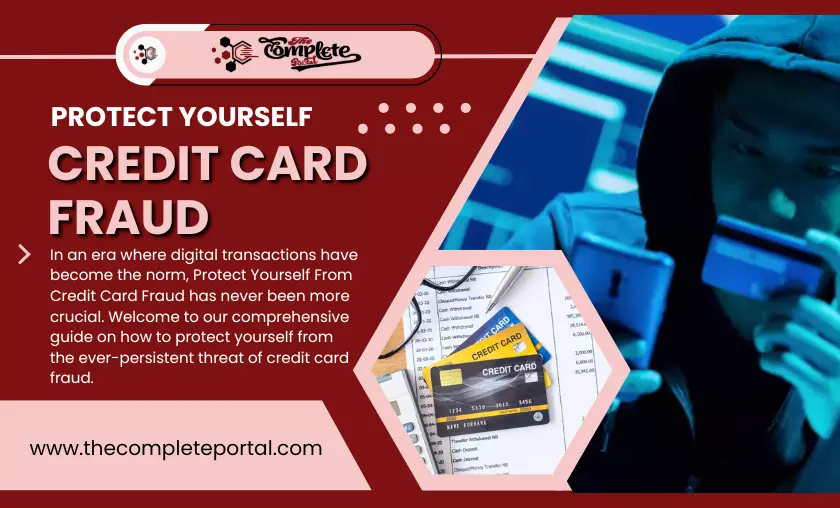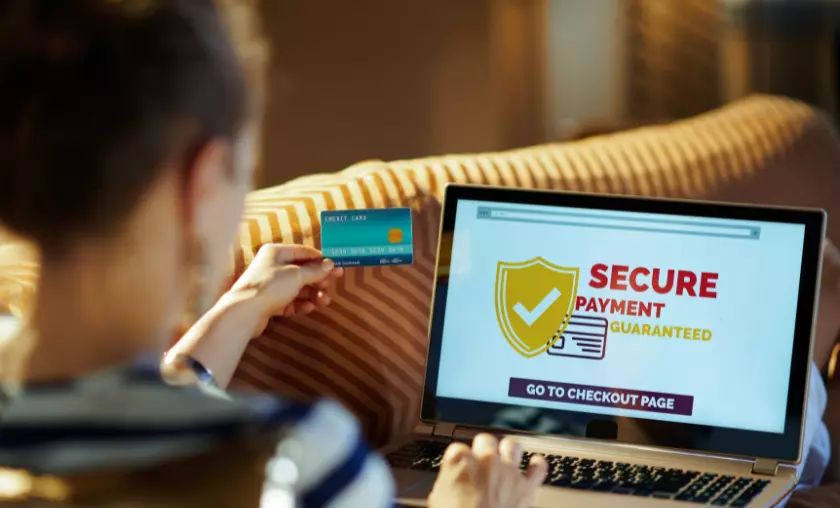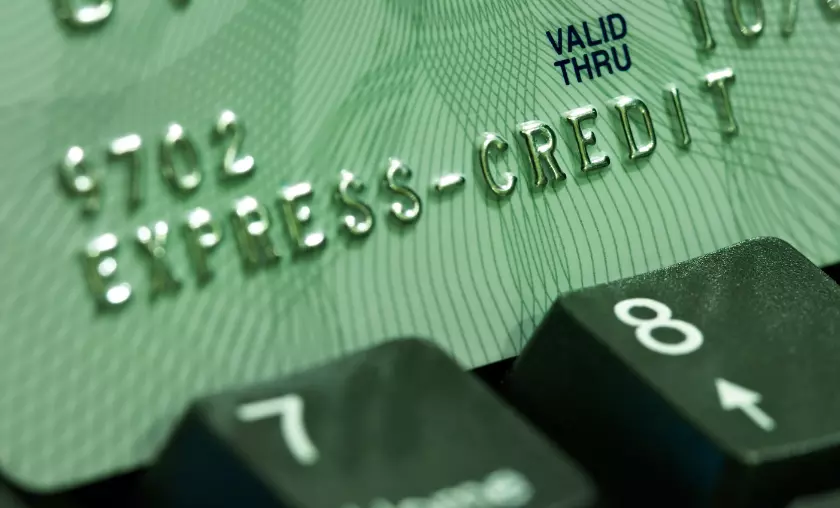
In an era where digital transactions have become the norm, Protect Yourself From Credit Card Fraud has never been more crucial. Welcome to our comprehensive guide on how to protect yourself from the ever-persistent threat of credit card fraud. As technology advances, so do the tactics employed by cybercriminals, making it imperative for all of us to stay one step ahead.
From simple yet effective preventive measures to recognizing warning signs and taking swift action, we’ll equip you with the knowledge and tools to shield your hard-earned money. Your financial security is worth safeguarding; we’re here to help you do that.
Protect Yourself From Credit Card Fraud
Understanding Credit Card Fraud
Understanding credit card fraud and how it happens is crucial in today’s digital age. Fraudulent activities often involve unauthorized use of credit card information to make purchases or withdraw funds, typically without the cardholder’s knowledge or consent.
Common methods include phishing emails, where scammers trick individuals into revealing card details, or card skimming devices placed on ATMs or payment terminals to capture card information. Online data breaches and hacking incidents are also common sources of stolen credit card information.
Common Methods Used by Fraudsters to Target Your Card
Vigilance and preventive measures, such as regularly monitoring your statements, securing your cards, and using strong, unique passwords, can help protect against credit card fraud and secure your financial information.
Monitoring Your Statements
The First Line of Defense
Monitoring your financial statements is the first defense against unauthorized transactions and potential fraud. Regularly reviewing your bank and credit card statements allows you to promptly spot discrepancies or unfamiliar charges. This proactive approach empowers you to promptly report suspicious activity to your financial institution, mitigating the impact of fraud and ensuring your financial security.
In today’s digital age, where transactions happen at the speed of a click, staying vigilant and vigilant is essential in safeguarding your financial well-being.
- Spot Unauthorized Transactions: Regularly checking your statements enables you to identify any unfamiliar or unauthorized transactions, including purchases you didn’t make or withdrawals you didn’t initiate.
- Detect Errors: Statement checks help catch billing errors, duplicate charges, or incorrect amounts, allowing you to rectify these issues promptly.
- Monitor Account Activity: By reviewing your statements, you can monitor the overall activity in your accounts and ensure that all transactions align with your financial activities and expectations.
- Early Fraud Detection: Timely statement reviews can help you detect signs of fraud or identity theft, such as unusual account activity or unfamiliar vendors.
- Protect Your Finances: Taking action upon spotting suspicious transactions can prevent further financial loss and protect your credit score and financial well-being.
Secure Online Shopping
Safeguarding Your Information
Securing your online shopping experience and safeguarding your personal and financial information is paramount in the digital age. When making online purchases, ensure the website is secure, identifiable by “https://” in the URL and a padlock symbol. Use strong, unique passwords for your accounts, and consider enabling two-factor authentication when available.
Be cautious with sharing personal details, and only provide your credit card information to trusted and reputable retailers. Regularly monitor your bank and credit card statements for any unauthorized charges.
- Use Secure Websites: Only shop on websites with “https://” in the URL and a padlock symbol in the address bar. These signs indicate a secure, encrypted connection.
- Strong Passwords: Create strong, unique passwords for your online shopping accounts. Consider using a password manager to generate and store complex passwords.
- Two-Factor Authentication: Enable two-factor authentication whenever possible. This adds an extra layer of security by requiring a one-time code sent to your phone or email for account access.
- Shop from Trusted Retailers: Purchase from well-known and reputable online retailers. Be cautious when dealing with unfamiliar websites or sellers, especially on online marketplaces.
- Monitor Statements: Review your bank and credit card statements regularly for unauthorized or suspicious charges. Report discrepancies to your financial institution immediately to address potential fraud.
These precautions help protect your sensitive data and ensure a safe and enjoyable online shopping experience.
PIN & Password Safety
Guarding Access to Your Card
Protecting the Personal Identification Number (PIN) and passwords associated with your cards is essential in maintaining the security of your financial accounts. Keep your PIN confidential and never share it with anyone. When selecting passwords, opt for strong, unique combinations that are difficult for others to guess. Avoid using easily accessible personal information, like birthdays or names, as passwords.
Changing your PIN and passwords regularly and avoiding public Wi-Fi networks when accessing sensitive accounts can further enhance the security of your financial information.
Significance of Strong & Unique PINs & Passwords
These simple yet critical measures help safeguard your cards and the financial assets they represent.
Recognizing Phishing Attempts
Emails & Calls
Recognizing phishing attempts through emails or phone calls is crucial in today’s interconnected world. Phishing often involves deceptive messages or calls that aim to trick you into revealing sensitive information like passwords or credit card details.
Be cautious of unsolicited emails, especially if they ask for personal or financial information, and avoid clicking on suspicious links or downloading attachments from unknown sources. Similarly, if you receive a phone call requesting sensitive information or immediate action, verify the caller’s identity independently before sharing any data.
- Check Sender Details: Examine the sender’s email address or caller ID for inconsistencies or unusual elements. Legitimate organizations typically use professional, consistent contact information.
- Look for Urgency or Threats: Scam messages often create a sense of urgency or use threatening language to pressure you into taking immediate action. Be skeptical of such messages.
- Avoid Clicking on Links: Don’t click on links in suspicious emails or messages. Instead, hover your mouse over the link to see the destination URL, and if it seems unusual, don’t proceed.
- Verify Requests: If you receive an email or call requesting sensitive information or money, independently verify the request by contacting the organization or individual through official contact information, not the information provided in the message.
- Stay Informed: Stay up-to-date on common scam tactics and trends. Many legitimate organizations and government agencies provide resources and alerts about current scams to help you stay informed and avoid falling victim.
Vigilance is your best defense against falling victim to phishing scams, helping protect your personal and financial security.
Card Verification Methods
Adding Extra Layers of Security
Card Verification Methods (CVMs) are essential tools in bolstering the security of your card transactions. They add extra layers of protection by requiring you to verify your identity during a purchase.
Common CVMs include the card’s three-digit CVV or CVC code, typically found on the back of the card, and the PIN (Personal Identification Number) used for in-person transactions. These methods help ensure that only the authorized cardholder can complete a transaction, reducing the risk of unauthorized use in physical and online purchases.
- Preventing Unauthorized Transactions: CVV (Card Verification Value) codes and Chip-and-PIN technology add a layer of security by requiring cardholders to provide a physical card or a unique code. This helps prevent unauthorized transactions, as fraudsters typically lack this information.
- Reducing Online Fraud: CVVs are particularly effective in online transactions. They ensure the card is physically present during the transaction, reducing the risk of card-not-present fraud.
- Combating Counterfeiting: Chip-and-PIN technology makes it extremely difficult for fraudsters to counterfeit physical cards. The embedded chip generates a unique code for each transaction, making cloned cards ineffective.
- Enhancing Data Protection: These security measures help protect sensitive cardholder data, reducing the risk of data breaches and identity theft.
- Minimizing Cardholder Liability: In cases of unauthorized transactions, cardholders are often protected by their card issuer’s fraud liability policies, limiting their financial responsibility for fraudulent charges.
By embracing these security measures, cardholders can have greater confidence in the safety of their financial transactions.
Lost or Stolen Cards
Swift Action for Recovery
In the event of a lost or stolen card, taking swift action is paramount to secure your finances. Contact your card issuer immediately to report the loss or theft. Most financial institutions offer 24/7 customer service to assist with such emergencies.
They can block your card to prevent unauthorized use and guide you through the process of ordering a replacement card. This prompt action protects your financial assets and minimizes the potential for fraudulent charges. It’s a proactive step towards regaining control and peace of mind during a challenging situation.
- Contact Your Card Issuer: Immediately call your card issuer’s customer service number, which is typically available 24/7. Report the card as lost or stolen to prevent unauthorized use.
- Monitor Account Activity: Regularly check your account statements and transactions for any unauthorized charges. Report any suspicious activity to your card issuer promptly.
- Request a Replacement Card: Your card issuer can guide you through ordering a replacement card with a new account number and security features.
- Update Automatic Payments: If you have recurring payments with your card, notify the respective companies or individuals about the card change to avoid payment disruptions.
- Consider a Card Lock or Freeze: Some card issuers offer the option to temporarily lock or freeze your card if you misplace it temporarily, but believe you’ll find it soon. This prevents new transactions until you unlock it.
Reporting Fraud
Taking Action Against Unauthorized Charges
Reporting fraud is critical in taking action against unauthorized charges and safeguarding your financial well-being. If you notice any transactions you did not authorize on your account, contact your card issuer or bank immediately to report the fraudulent activity. They can initiate an investigation, freeze the affected card or account, and work to reverse any unauthorized charges.
- Contact Your Card Issuer or Bank: Immediately call the customer service number provided by your card issuer or bank to report the fraudulent transactions. They can initiate an investigation and guide you through the resolution process.
- Provide Necessary Information: Be prepared to provide details about the unauthorized charges, such as the date, time, and amount of each transaction. This information will assist in the investigation.
- Request a Dispute Form: Your card issuer may require you to fill out a dispute form to formally report the fraudulent activity. Ask for one if needed and complete it accurately.
- Freeze or Close the Affected Account: If necessary, your card issuer can temporarily freeze or close the affected account to prevent further unauthorized transactions while the investigation is ongoing.
- Follow Up Regularly: Stay in touch with your card issuer or bank to monitor the progress of the investigation and ensure that the unauthorized charges are resolved promptly. They should work to remove the fraudulent transactions and restore any lost funds to your account.
Prompt reporting helps protect your financial assets and plays a vital role in preventing further fraudulent activity and ensuring a quicker resolution to the issue.
Preventive Measures
Proactive Steps to Keep Your Card Safe
Preventive measures are crucial to keeping your card safe in an increasingly digital world. Start by regularly monitoring your card statements and account activity for suspicious transactions. Additionally, only share your card information with trusted, reputable sources, whether online or offline.
When making online purchases, ensure the website is secure and authenticated. Guard your card’s PIN and never disclose it to anyone. Consider setting up transaction alerts to receive notifications of card activity.
Strategies to Minimize the Risk of Credit Card Fraud
These proactive steps protect your financial information and provide peace of mind in an age where card security is paramount.
Conclusion
In conclusion, safeguarding yourself from credit card fraud is paramount in today’s digital age. By implementing a combination of proactive measures and maintaining vigilant awareness, you can significantly reduce the risk of falling victim to this pervasive financial crime. Regularly monitor your statements, scrutinize transactions, and promptly report any suspicious activity to your card issuer.
Embrace the security features offered by your card company, such as two-factor authentication and real-time alerts. Be cautious when sharing personal and financial information online, and only do so with reputable and secure websites. Employ strong, unique passwords for your accounts, and consider using a reliable password manager.
FAQ’s
What Should I Do if I Suspect Credit Card Fraud?
If you suspect credit card fraud, contact your card issuer immediately to report the unauthorized transactions. They can guide you through the necessary steps to dispute the charges and protect your account.
Are EMV Chip Cards Safer Than Traditional Magnetic Stripe Cards?
EMV chip cards provide an added layer of security compared to magnetic stripe cards. They generate unique transaction codes for each purchase, making it harder for fraudsters to clone cards. However, no card is entirely immune to fraud.
How Can I Protect My Credit Card When Shopping Online?
When shopping online, only use secure websites with “https://” in the URL, and look for trust indicators like padlock icons. Avoid saving card details on websites and use a dedicated, secure payment method like PayPal when available.
Are Mobile Payment Apps Secure for Transactions?
Most reputable mobile payment apps employ strong encryption and security measures. However, it’s crucial to secure your device with a PIN or biometric authentication and regularly update the app to benefit from the latest security enhancements.
Can I Prevent Credit Card Fraud Entirely?
While you can’t guarantee absolute prevention, you can significantly reduce your risk by practicing vigilance, using secure online habits, and staying informed about evolving fraud tactics. Combining these strategies will help you protect yourself from credit card fraud to a great extent.
To Read More Similar Articles, Click Here.
Thanks for Visiting Our Website. If You Appreciate Our Work, Kindly Show Us Some Support in Our Comments Section 🙂


